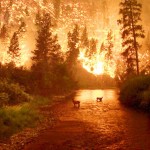Wildlife on the Run.
By Paul Stein
The Rim Fire in Tuolumne County has consumed over 250,000 acres and is only 50% contained. Now the 4th largest wildfire in the State’s history, some estimate it won’t be fully contained until October. While the economic devastation is undeniable, the long-range impact on wildlife is of even greater concern.
Mixed conifer forests, like those in the Sierra Nevada, have evolved with the regular incidence of fire occurring every 5 to 300 years, depending on the local climate. In prehistoric times, lightening was the ignition source. Later, Native Americans typically set fires during fall and winter at higher elevations before retreating for winter. This practice kept the forest from becoming too overgrown and increased the vigor and diversity of the ecosystem. Forest ecology and wildlife flourished following low intensity fires that burn close to the ground. Many plants evolved the ability to withstand frequent fire and in some cases even depend on it. Under normal circumstances, fires can be a healthy event in the forest, releasing nutrients from dead trees and brush back into the soil.
But when the forest environment becomes overgrown and choked with decade’s worth of dead trees and undergrowth, a devastating fire will inevitably occur. It’s only a matter of time.
Animals, like plants, display a range of abilities to cope with fire. But they differ from plants in that they must avoid the actual fire to survive. For most animals, periodic wildfires are something they have adapted to after living in fire prone areas for eons. It is not uncommon for large mammals such as dear, moose and elk to graze calmly while slow burning fires burn only a few hundred yards away. In most cases of slow burning fires, larger mammals, birds, and flying insects can escape to safety, while smaller species of reptiles, arthropods, and insects, will burrow underground in an effort to escape the heat. Amphibians are able to take refuge in water or very wet mud. Microbial organisms in the soil vary in their heat tolerance but are more likely to survive a fire the deeper they are in the soil. An increase in available nutrients after the fire has passed may result in larger microbial communities than before the fire.As a result, for slow burning fires direct fire-caused mortality among these microbes is generally low.
 Mortality is more likely when fires are large, intense, and produce a lot of ground smoke like the Rim Fire. The intensity of a fire describes the energy released, while severity describes the magnitude of effect. Intense fires release more energy by devastating more trees and plant species, which affects the wildlife habitat. California fires are typically very severe and fast burning. They differ in that they are not usually fueled by winds; only tender-dry brush and trees. California wildfire temperatures often exceed a staggering 2000 degrees Fahrenheit, incinerating everything in its path down to a fine ash-dust.
Mortality is more likely when fires are large, intense, and produce a lot of ground smoke like the Rim Fire. The intensity of a fire describes the energy released, while severity describes the magnitude of effect. Intense fires release more energy by devastating more trees and plant species, which affects the wildlife habitat. California fires are typically very severe and fast burning. They differ in that they are not usually fueled by winds; only tender-dry brush and trees. California wildfire temperatures often exceed a staggering 2000 degrees Fahrenheit, incinerating everything in its path down to a fine ash-dust.
Habitat modification after the fire poses a much greater threat to animals than the fire itself. Immediately following a fire, many animals are forced to move to other areas in order to find food and/or shelter. The length of time animals are forced to move out of a burned area depends heavily on the size and severity of the burn, as well as the season during which the burn takes place. Some animals, particularly small mammals, will experience relatively large population declines immediately after a fire. In most cases, it is the indirect effects that impact wildlife, such as a lack of available food, water, and shelter.
Other animals, especially birds of prey have also been known to return to a burned forest within only a few days. In particular owls prefer and even thrive in recently burned forests. The reduction in undergrowth and ground debris can expose small rodents making hunting easier for these raptors.
Although large wildfires have an immediate negative impact on fish populations—mostly trout and salmon—in the long-term studies show that a fire can actually rejuvenate fish habitats. Heavy silt from runoff causes increased turbidity that hinders egg production in the year immediately following a wildfire. But this increased runoff from burned over areas actually promotes hydraulic changes in the river system. The resulting flooding removes years of accumulated silt and increases the deposition of a favorable habitat substrate. This leads to larger post-fire populations of the fish that are able to re-colonize these improved areas.
The California Department of Fish and Wildlife recommends that if an abandoned or injured animal is discovered near burned areas, contact an experienced wildlife rescue organization that can capture and care for the animal until it can be released. Sierra Wildlife Rescue located in Placerville can be reached at: 530-621-4661 or email at [email protected]
Remember the old adage from Smoky the Bear: ‘Only you can prevent forest fires’? It may be that Ol’ Smoky has done too good a job. Fire is a naturally occurring phenomenon in nature, but when the forest environment becomes choked with brush and is out of balance catastrophic fires are the result. Better to manage the land and its resources by introducing fire and responsible harvesting techniques rather than letting it go to waste. Only then can the devastation of conflagrations the size of the Rim Fire be prevented.
Paul Stein is a biologist with a long career in aquaculture. He was formerly chief deputy director of the California Department of Fish & Wildlife. He can be reached at [email protected]



